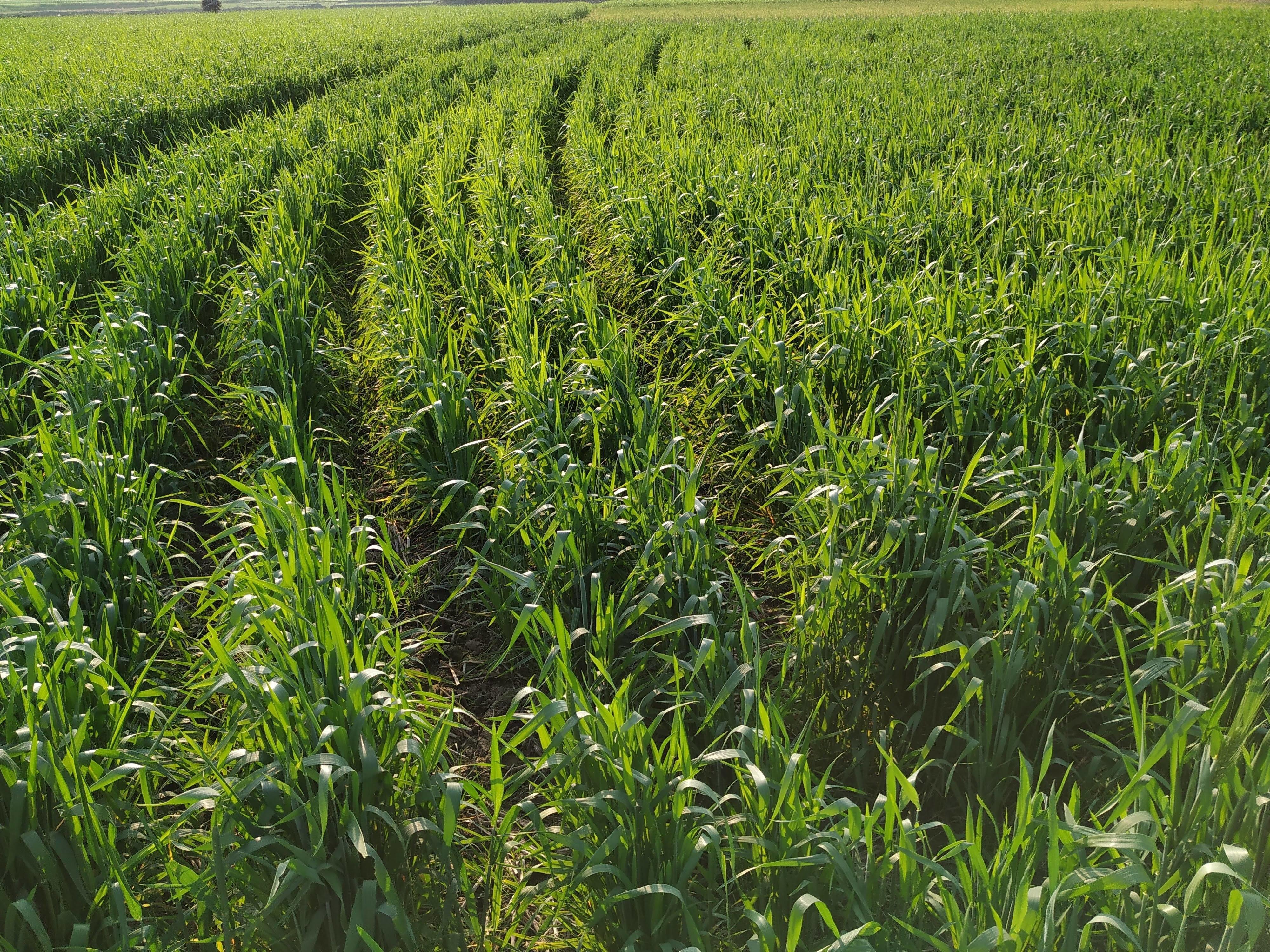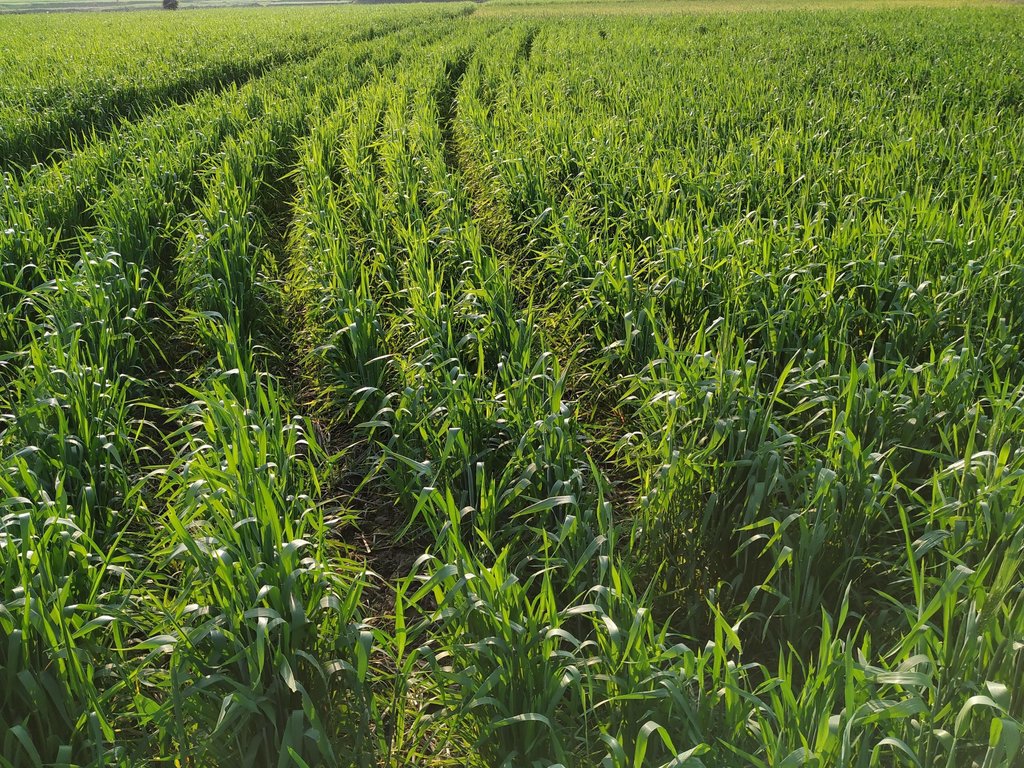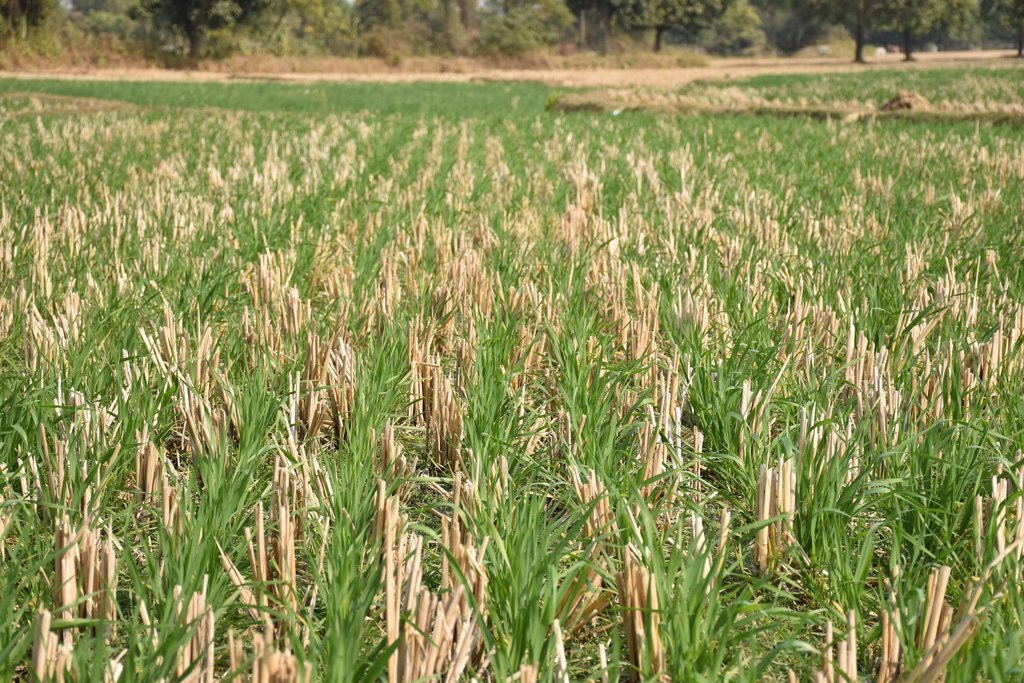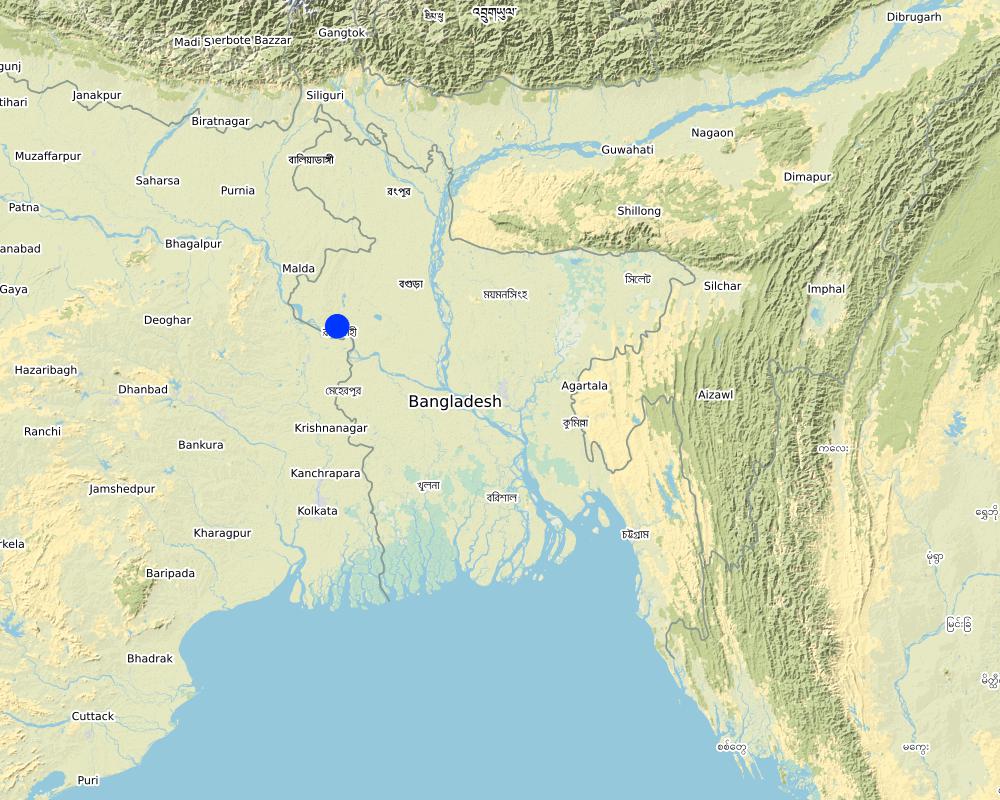Strip tillage wheat production in degraded terraces of High Barind Tract, Rajshahi [孟加拉国]
- 创建:
- 更新:
- 编制者: Mutasim Billah
- 编辑者: Matieu Henry
- 审查者: Nicole Harari, Rima Mekdaschi Studer, Ursula Gaemperli
Barendra Bhumite sarite gom abad
technologies_4670 - 孟加拉国
查看章节
全部展开 全部收起1. 一般信息
1.2 参与该技术评估和文件编制的资源人员和机构的联系方式
土地使用者:
Islam Md. Serajul
Farmer
孟加拉国
co-compiler:
Roy Tapan
Department of Agricultural Extension (DAE), Paba, Rajshshi
孟加拉国
有助于对技术进行记录/评估的项目名称(如相关)
Decision Support for Mainstreaming and Scaling out Sustainable Land Management (GEF-FAO / DS-SLM)有助于对技术进行记录/评估的机构名称(如相关)
FAO Bangladesh (FAO Bangladesh) - 孟加拉国有助于对技术进行记录/评估的机构名称(如相关)
Department of Agricultural Extension (DAE) - 孟加拉国1.3 关于使用通过WOCAT记录的数据的条件
编制者和关键资源人员接受有关使用通过WOCAT记录数据的条件。:
是
1.4 所述技术的可持续性声明
这里所描述的技术在土地退化方面是否存在问题,导致无法被认为是一种可持续的土地管理技术?:
否
2. SLM技术的说明
2.1 技术简介
技术定义:
Strip tillage wheat cultivation is a climate-smart technology to save water and improve soil health
2.2 技术的详细说明
说明:
The High Barind Tract (HBT) situated in north-western region of Bangladesh consisting Rajshahi, Chapai Nawabganj and Naogaon Districts where the underlying Madhupur clay soil has been uplifted and cut into by deep valleys. The topsoil of HBT is grey silt loam to silty clay loam, is strongly puddled and has a compact ploughpan at the base. Deep grey terrace soils and grey valley soil are the major components of the general soil types of this area.
Strip tillage wheat cultivation is being adopted in farmers field on which wheat has been cultivated for decades. Bangladesh Agricultural Research Institute (BARI) developed this technology/innovation, and Department of Agricultural Extension (DAE) and International Maize and Wheat Improvement Center (CIMMYT) disseminated the technology also among farmers of Rajshahi region. In brief, strip tillage wheat is a water saving technology, and requires wheat to be planted in rows. Traditionally, farmers cultivated wheat using the broadcast method, after deep tilling the land 3-4 times and after flood irrigation. In this new method, farmers can use a strip tiller that sows seeds and fertilizer simultaneously immediately after T. Aman rice (Transplanted rice, Aman is the Kharif 2 season from June to November) harvesting. This implies that retained soil moisture can germinate the wheat seeds. Because the wheat seeds are sown in a row, sunlight and air penetrate very well; and weed infestation remains low because of minimum tillage. Farmers report that rodent infestation in strip tillage is lower than conventional broadcast cultivation.
As stated, a strip tiller is needed for this operation, and the machine is a modified version of traditional power tiller developed by BARI. The tiller has thin ploughs in parallel rows (four to a machine), and drops the fertilizer and seed – another wheel-like device presses the seed into the soil. The other parts of land remain unplowed that keep moisture and resist weeds to grow. Retention of rice crop residue increases soil organic matter which in turn increases the soil water retention/holding capacity and loosens the soil (for free drainage).
Overall, this water saving technology has increased livelihood options for tiller machine service providers, decreased on-farm input costs (e.g., irrigation, rodenticide), and increased wheat productivity (by improve weather – storm/wind – resistance of crops and reducing rodent infestation). Moreover, it produces quality wheat, increases the grain weight, and makes wheat easy to harvest. The yield of strip cultivated wheat is reported to be 1.25 times higher than conventional wheat.
2.3 技术照片
2.5 已应用该技术的、本评估所涵盖的国家/地区/地点
国家:
孟加拉国
区域/州/省:
Rajshahi
有关地点的进一步说明:
Paba
具体说明该技术的分布:
- 均匀地分布在一个区域
技术现场是否位于永久保护区?:
否
注释:
Farmers are cultivating strip tillage wheat in their own field
Map
×2.6 实施日期
注明实施年份:
2016
如果不知道确切的年份,请说明大概的日期:
- 不到10年前(最近)
2.7 技术介绍
详细说明该技术是如何引入的:
- 通过土地使用者的创新
- 作为传统系统的一部分(> 50 年)
- 在实验/研究期间
- 通过项目/外部干预
注释(项目类型等):
Wheat cultivated in HBT since long ago and the farmer often faced high input cost in traditional cultivation method. BARI Regional Research Station conducted a lot of research on wheat to minimise the input cost and gaining more yield through different projects with farmer. With the help of local farmer, BARI, CIMMYT and DAE demonstrated improved technology for wheat. After trial and trial BARI scientist and the enlisted local service provider developed the light power tiller driven device for strip tillage wheat cultivation.
3. SLM技术的分类
3.1 该技术的主要目的
- 改良生产
- 减少、预防、恢复土地退化
- 降低灾害风险
- 减缓气候变化及其影响
- 创造有益的经济影响
3.2 应用该技术的当前土地利用类型
同一土地单元内混合使用的土地::
否

农田
- 一年一作
年作 - 具体指明作物:
- 谷类 - 水稻(湿地)
- 谷类 - 小麦(春季)
- 豆科牧草和豆类 - 豆子
- Legume: eg. Mung bean. (T.Aman rice - Wheat - Mung bean)
每年的生长季节数:
- 3
具体说明:
Wetland rice - wheat - pulse
采用间作制度了吗?:
否
采用轮作制度了吗?:
是
如果是,请具体说明:
rice than wheat than pulse
3.3 由于技术的实施,土地使用是否发生了变化?
由于技术的实施,土地使用是否发生了变化?:
- 否(继续问题3.4)
同一土地单元内混合使用的土地::
否
3.4 供水
该技术所应用土地的供水:
- 混合雨水灌溉
注释:
Barind Multipurpose Development Authority (BMDA) established deep tubewell for irrigation to farmers. Generally, farmer use deep tubewell water for irrigation. Also, farmer use surface water from canal for irrigation purpose.
3.5 该技术所属的SLM组
- 轮作制度(轮作、休耕、轮垦)
- 改良的地面/植被覆盖
- 最小的土壤扰动
3.6 包含该技术的可持续土地管理措施

农艺措施
- A1:植被和土壤覆盖层
- A2:有机质/土壤肥力
- A3:土壤表面处理
- A6:残株管理
A3:区分耕作制度:
A 3.2: Reduced tillage (> 30% soil cover)
A6:对残株管理作出具体说明:
A 6.4:保留

结构措施
- S1:阶地

管理措施
- M2:改变管理/强度级别
- M4:活动时间安排的重大变化
3.7 该技术强调的主要土地退化类型

土壤水蚀
- Wt:表土流失/地表侵蚀

土壤风蚀
- Et:表土流失

化学性土壤退化
- Cn:肥力下降和有机质含量下降(非侵蚀所致)

物理性土壤退化
- Pc:压实
- Pi:覆土
- Pw:水浸
- Ps:有机土壤沉降,土壤沉降

生物性退化
- Bc:植被覆盖的减少
- Bq:数量/生物量减少
- Bl:土壤寿命损失

水质恶化
- Hs:地表水良变化
- Hg:地下水/含水层水位的变化
- Hp:地表水水质下降
- Hq:地下水水质下降
3.8 防止、减少或恢复土地退化
具体数量名该技术与土地退化有关的目标:
- 防止土地退化
4. 技术规范、实施活动、投入和成本
4.1 该技术的技术图纸
技术规范(与技术图纸相关):
Machine and device used: Two wheel drive walking type power tiller and attached strip tiller device
Row to row distance: 20 cm
Plant to plant distance: 5 cm (mainly keep continuous seeding)
Depth of row: 5 cm
Crop residue: paddy straw
作者:
Md. Mutasim Billah
日期:
17/04/2019
4.2 有关投入和成本计算的一般信息
具体说明成本和投入是如何计算的:
- 每个技术区域
注明尺寸和面积单位:
Bigha
如果使用本地面积单位,注明转换系数为1公顷(例如1公顷=2.47英亩):1公顷=:
1 Hectare = 7.48 Bigha
具体说明成本计算所用货币:
- 美元
注明雇用劳工的每日平均工资成本:
USD 4.7
4.3 技术建立活动
注释:
No establishment cost needed, because it is a short term annual crop
4.5 维护/经常性活动
| 活动 | 时间/频率 | |
|---|---|---|
| 1. | Herbicide application in field | November - December |
| 2. | Seed treatment | November - December |
| 3. | Tillage (Strip) and seed sowing | November - December |
| 4. | Fertilizer application | November - December |
| 5. | Irrigation | January - March |
| 6. | Pesticide application | January - February |
| 7. | Harvesting | April |
| 8. | Threshing | April |
注释:
At best 2 irrigation is needed depending on soil moisture
4.6 维护/经常性活动所需要的费用和投入(每年)
| 对投入进行具体说明 | 单位 | 数量 | 单位成本 | 每项投入的总成本 | 土地使用者承担的成本% | |
|---|---|---|---|---|---|---|
| 劳动力 | Herbicide application | Person-day | 1.0 | 4.7 | 4.7 | 100.0 |
| 劳动力 | Harvesting | Person-day | 5.0 | 4.7 | 23.5 | 100.0 |
| 劳动力 | Threshing | Person-day | 2.0 | 4.7 | 9.4 | 100.0 |
| 设备 | Two wheel strip tiller | Rent-Bigha | 1.0 | 5.88 | 5.88 | 100.0 |
| 设备 | Irrigation and its equipment charge | Day | 3.0 | 4.11 | 12.33 | 100.0 |
| 植物材料 | Wheat seed | Kg | 18.0 | 0.59 | 10.62 | 100.0 |
| 肥料和杀菌剂 | Fertilizer | kg | 70.0 | 0.26 | 18.2 | 100.0 |
| 肥料和杀菌剂 | Herbicide | Kg | 0.4 | 4.5 | 1.8 | 100.0 |
| 肥料和杀菌剂 | Seed treatment chemicals | Kg | 0.5 | 4.0 | 2.0 | 100.0 |
| 肥料和杀菌剂 | Pesticide | Kg | 3.0 | 3.26 | 9.78 | 100.0 |
| 技术维护所需总成本 | 98.21 | |||||
| 技术维护总成本,美元 | 98.21 | |||||
4.7 影响成本的最重要因素
描述影响成本的最决定性因素:
Time of seed sowing: the yield will reduce after 30 November
Irrigation: it is critical in tillering and penicle initiation stage, the yield may reduced. The source of irrigation is BMDA deep tubewell and from canal.
5. 自然和人文环境
5.1 气候
年降雨量
- < 250毫米
- 251-500毫米
- 501-750毫米
- 751-1,000毫米
- 1,001-1,500毫米
- 1,501-2,000毫米
- 2,001-3,000毫米
- 3,001-4,000毫米
- > 4,000毫米
指定年平均降雨量(若已知),单位为mm:
1410.00
有关降雨的规范/注释:
Average rainfall in High Barind Tract is much lower than other parts of country
注明所考虑的参考气象站名称:
Weather Atlas; {https://www.weather-atlas.com/en/bangladesh/rajshahi-climate#rainfall}
农业气候带
- 半湿润
5.2 地形
平均坡度:
- 水平(0-2%)
- 缓降(3-5%)
- 平缓(6-10%)
- 滚坡(11-15%)
- 崎岖(16-30%)
- 陡峭(31-60%)
- 非常陡峭(>60%)
地形:
- 高原/平原
- 山脊
- 山坡
- 山地斜坡
- 麓坡
- 谷底
垂直分布带:
- 0-100 m a.s.l.
- 101-500 m a.s.l.
- 501-1,000 m a.s.l.
- 1,001-1,500 m a.s.l.
- 1,501-2,000 m a.s.l.
- 2,001-2,500 m a.s.l.
- 2,501-3,000 m a.s.l.
- 3,001-4,000 m a.s.l.
- > 4,000 m a.s.l.
说明该技术是否专门应用于:
- 凸形情况
5.3 土壤
平均土层深度:
- 非常浅(0-20厘米)
- 浅(21-50厘米)
- 中等深度(51-80厘米)
- 深(81-120厘米)
- 非常深(> 120厘米)
土壤质地(表土):
- 细粒/重质(粘土)
土壤质地(地表以下> 20厘米):
- 细粒/重质(粘土)
表土有机质:
- 低(<1%)
5.4 水资源可用性和质量
地下水位表:
5-50米
地表水的可用性:
匮乏/没有
水质(未处理):
良好饮用水
水质请参考::
地下水
水的盐度有问题吗?:
否
该区域正在发生洪水吗?:
否
关于水质和水量的注释和进一步规范:
Both irrigation and drinking water extracted from deep tubewell of Barind Multipurpose Development Authority (BMDA)
5.5 生物多样性
物种多样性:
- 低
栖息地多样性:
- 低
5.6 应用该技术的土地使用者的特征
定栖或游牧:
- 定栖的
生产系统的市场定位:
- 生计(自给)
- 混合(生计/商业)
非农收入:
- 低于全部收入的10%
相对财富水平:
- 非常贫瘠
- 贫瘠
个人或集体:
- 个人/家庭
机械化水平:
- 手工作业
- 机械化/电动
性别:
- 男人
土地使用者的年龄:
- 中年人
- 老年人
5.7 应用该技术的土地使用者使用的平均土地面积
- < 0.5 公顷
- 0.5-1 公顷
- 1-2 公顷
- 2-5公顷
- 5-15公顷
- 15-50公顷
- 50-100公顷
- 100-500公顷
- 500-1,000公顷
- 1,000-10,000公顷
- > 10,000公顷
这被认为是小规模、中规模还是大规模的(参照当地实际情况)?:
- 小规模的
5.8 土地所有权、土地使用权和水使用权
土地所有权:
- 个人,有命名
土地使用权:
- 个人
用水权:
- 社区(有组织)
- 个人
土地使用权是否基于传统的法律制度?:
是
具体说明:
Most of the land owned by land lord and they give taxes to government in year basis. The land owner lease the land to small, marginal and landless farmer in year basis. The land owner take money from them, and sometimes land owner share the crop with lease-taking farmer.
5.9 进入服务和基础设施的通道
健康:
- 贫瘠
- 适度的
- 好
教育:
- 贫瘠
- 适度的
- 好
技术援助:
- 贫瘠
- 适度的
- 好
就业(例如非农):
- 贫瘠
- 适度的
- 好
市场:
- 贫瘠
- 适度的
- 好
能源:
- 贫瘠
- 适度的
- 好
道路和交通:
- 贫瘠
- 适度的
- 好
饮用水和卫生设施:
- 贫瘠
- 适度的
- 好
金融服务:
- 贫瘠
- 适度的
- 好
6. 影响和结论性说明
6.1 该技术的现场影响
社会经济效应
生产
作物生产
作物质量
生产故障风险
生产区域
土地管理
水资源可用性和质量
灌溉用水的可用性
灌溉用水需求
收入和成本
农业投入费用
农业收入
收入来源的多样性
工作量
社会文化影响
食品安全/自给自足
SLM/土地退化知识
生态影响
水循环/径流
水量
多余水的排放
地下水位/含水层
蒸发
土壤
土壤水分
土壤覆盖层
土壤流失
土壤结壳/密封
土壤压实
养分循环/补给
土壤有机物/地下C
生物多样性:植被、动物
植被覆盖
生物量/地上C
害虫/疾病控制
注释/具体说明:
Rodent infestation decreased
减少气候和灾害风险
干旱影响
碳和温室气体的排放
微气候
6.2 该技术的场外影响已经显现
水资源可用性
地下水/河流污染
温室气体的影响
6.3 技术对渐变气候以及与气候相关的极端情况/灾害的暴露和敏感性(土地使用者认为的极端情况/灾害)
渐变气候
渐变气候
| 季节 | 增加或减少 | 该技术是如何应对的? | |
|---|---|---|---|
| 年温度 | 增加 | 好 | |
| 季节性温度 | 夏季 | 增加 | 好 |
| 年降雨量 | 减少 | 好 | |
| 季雨量 | 夏季 | 减少 | 好 |
气候有关的极端情况(灾害)
气象灾害
| 该技术是如何应对的? | |
|---|---|
| 热带风暴 | 适度 |
| 龙卷风 | 未知 |
气候灾害
| 该技术是如何应对的? | |
|---|---|
| 干旱 | 非常好 |
生物灾害
| 该技术是如何应对的? | |
|---|---|
| 昆虫/蠕虫侵扰 | 非常好 |
6.4 成本效益分析
技术收益与技术建立成本相比如何(从土地使用者的角度看)?
短期回报:
积极
长期回报:
非常积极
技术收益与技术维护成本/经常性成本相比如何(从土地使用者的角度看)?
短期回报:
非常积极
长期回报:
非常积极
6.5 技术采用
- 1-10%
在所有采用这项技术的人当中,有多少人是自发的,即未获得任何物质奖励/付款?:
- 11-50%
注释:
Some farmer got seed and sowing cost as incentive, but this number is too small (1-2%) from DAE. Most of the farmer grow wheat without any incentive.
6.6 适应
最近是否对该技术进行了修改以适应不断变化的条件?:
否
6.7 该技术的优点/长处/机会
| 土地使用者眼中的长处/优势/机会 |
|---|
|
- Low input cost that save plowing cost - Low water requirement |
| - No rodent infestation because of line sowing |
| - High yield |
| 编制者或其他关键资源人员认为的长处/优势/机会 |
|---|
| - Low GHG emission |
|
- Low input cost - Have scope for women engagement, especially in harvesting and threshing purpose |
|
- Increase soil health - Increase the organic matter through crop residue retention |
6.8 技术的弱点/缺点/风险及其克服方法
| 土地使用者认为的弱点/缺点/风险 | 如何克服它们? |
|---|---|
| Need machinery for this practice | Rent machinery |
| 编制者或其他关键资源人员认为的弱点/缺点/风险 | 如何克服它们? |
|---|---|
| - Timely seed sowing | - Short duration crop cultivation |
7. 参考和链接
7.1 信息的方法/来源
- 实地考察、实地调查
5
- 与土地使用者的访谈
4
- 与SLM专业人员/专家的访谈
3
(现场)数据是什么时候汇编的?:
14/02/2019
7.2 参考可用出版物
标题、作者、年份、ISBN:
STATUS OF CONSERVATION AGRICULTURE BASED TILLAGE TECHNOLOGY FOR CROP PRODUCTION IN BANGLADESH; M. ISRAIL HOSSAIN, M. J. U. SARKER AND M. ARSHADUL HAQUE; 2015; ISSN 0258-7122
可以从哪里获得?成本如何?
Internet, free
7.3 链接到网络上的相关信息
标题/说明:
STATUS OF CONSERVATION AGRICULTURE BASED TILLAGE TECHNOLOGY FOR CROP PRODUCTION IN BANGLADESH
URL:
https://www.banglajol.info/index.php/BJAR/.../16658
链接和模块
全部展开 全部收起链接
无链接
模块
无模块







